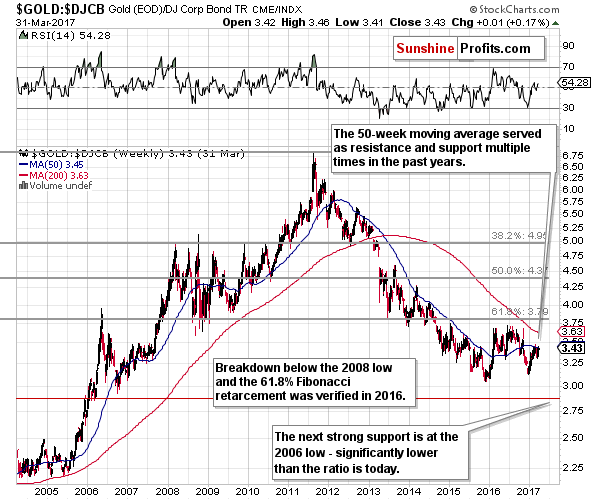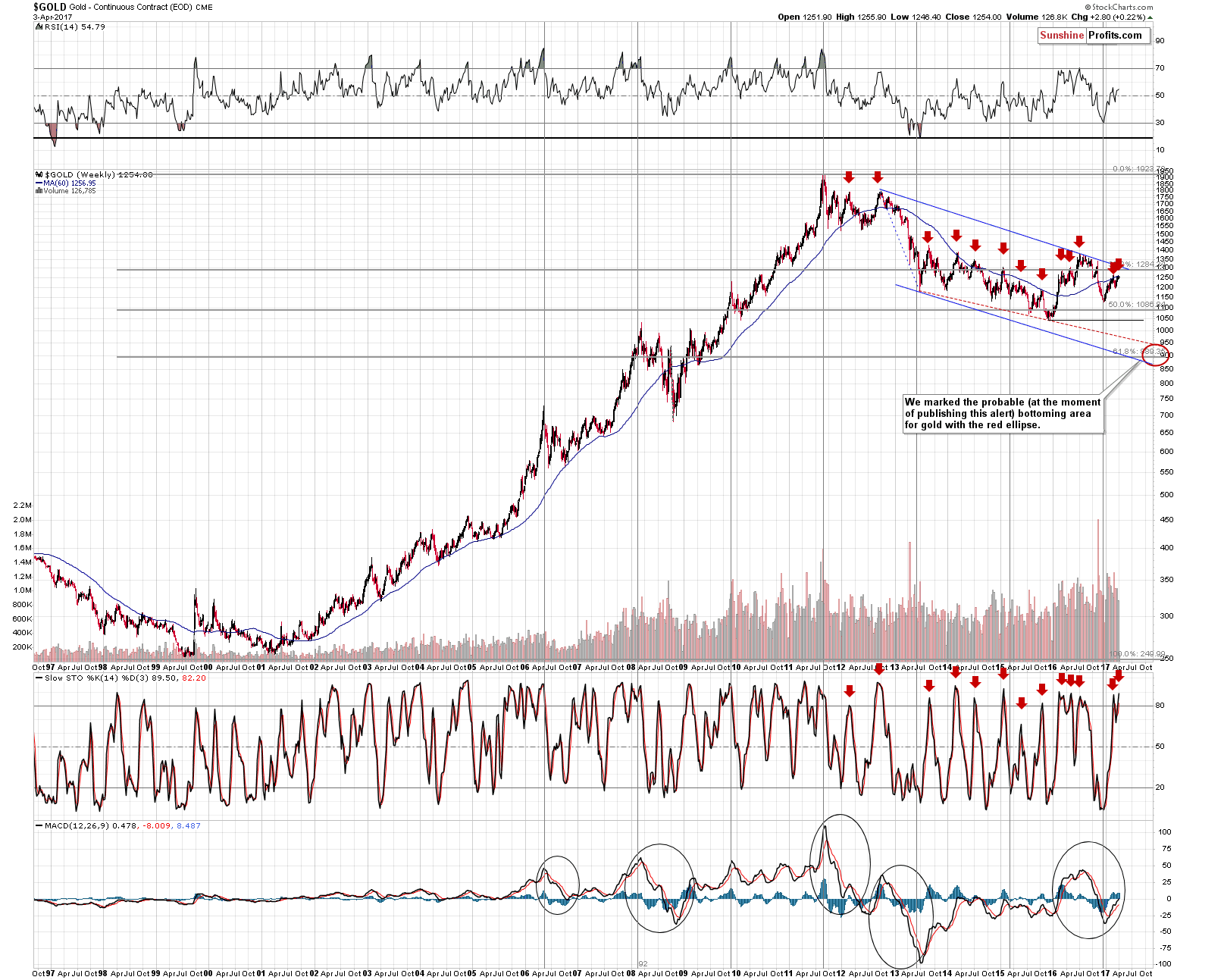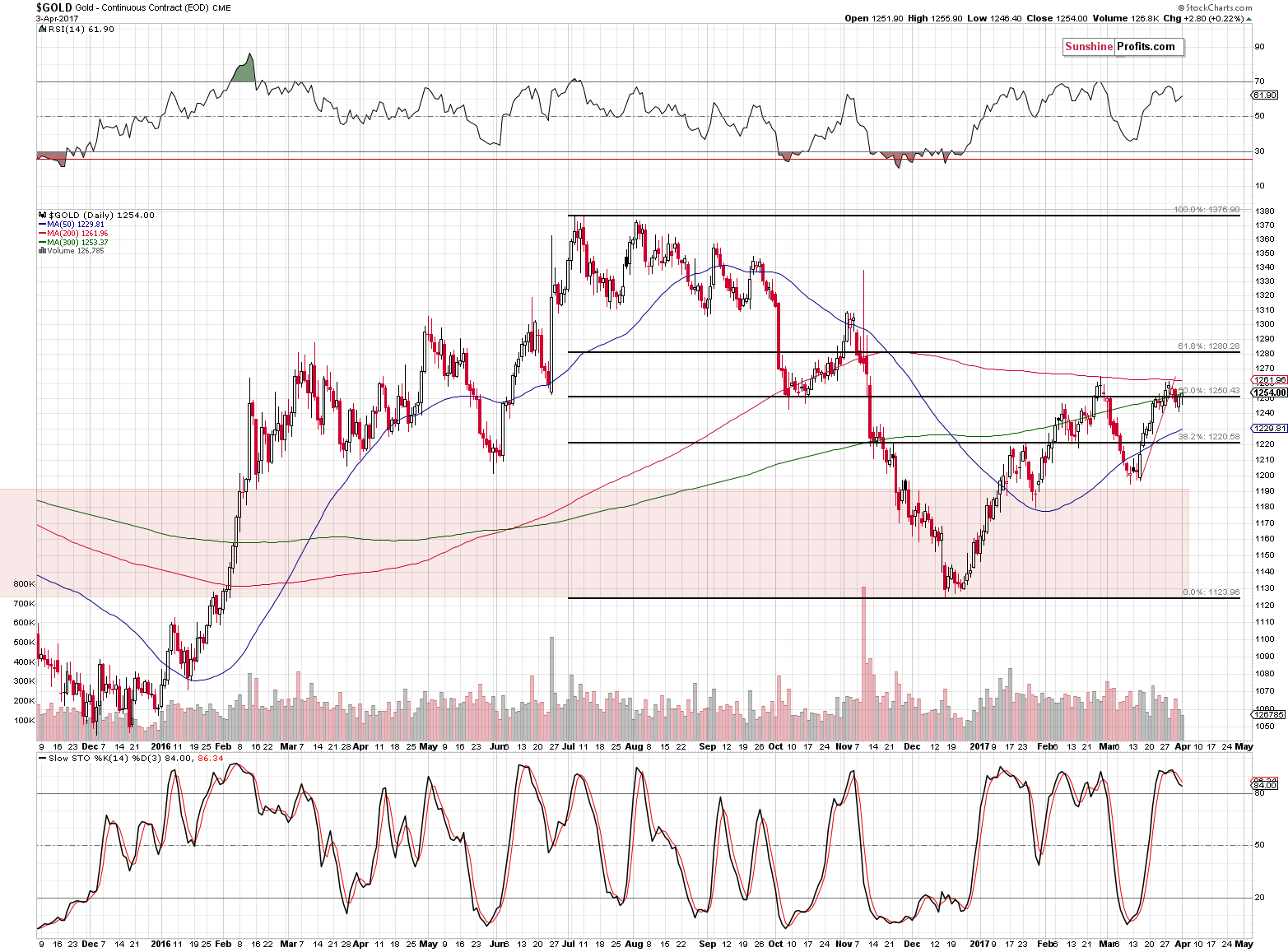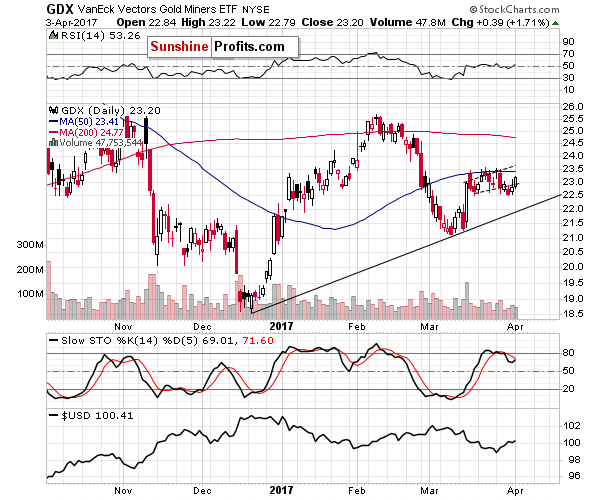Briefly: In our opinion, full (150% of the regular full position) speculative short positions in gold, silver and mining stocks are justified from the risk/reward perspective. This position was originally featured on Jan. 12, 2017 at 3:49PM.
In yesterday’s alert we discussed the important implications that the long-term silver charts have for the following weeks and months and in today’s alert we will discuss additional long-term factors. Namely, we’ll focus on the quite popular 50-week moving average and we’ll discuss it from both points of view: the popular one and the little known one.
Let’s start with the latter by discussing the long-term chart for the gold to bonds ratio (charts courtesy of http://stockcharts.com).

Analyzing the price of gold compared with the prices of corporate bonds is not a thing that many analysts do (and practically none of the beginning investors) and it’s understandable as long as they focus on the very short-term (1-4 days long) price moves. In other cases, the above chart should not be neglected as the resistance and support from it can have implications for the gold market itself. In fact, the reason we started today’s alert with this chart is because the 50-week moving average is more efficient as support and resistance for the ratio than for gold itself.
In almost all cases since 2012, whenever the ratio moved to the 50-week moving average it served as strong resistance or support and triggered a reversal. The only real exception (the temporary and small “breakouts” in late 2012 and early 2014 don’t really count) were the early 2016 rally and the post-Trump-victory slide. Except for the 2016 rally, all attempts to move above it failed or were invalidated. Interestingly, this moving average served as support twice in 2016 (the second time right before the final and temporary Trump-victory rally). That makes this moving average something that should definitely be monitored and taken into account.
What can we infer from it at this time? The ratio is once again practically right at the 50-week moving average and thus it's likely to reverse and move lower. That’s important as the ratio moves in tune with gold. Consequently, the above has very bearish implications for the yellow metal for the following weeks.
Besides, the entire 2016 rally seems to be a large verification of the breakdown below the 2008 lows and the 61.8% Fibonacci retracement based on the entire bull market. Again, the implications for the following months are bearish.

As discussed above, the 50-week moving average is something that’s important also in the case of gold, but that is not as efficient as it is in case of the ratio. The above chart shows that this is indeed the case – gold moved a bit above the moving average on most occasions before the top was formed. In fact, at the moment of writing these words, gold is above it as well (about $4 above it, but still). So, what does this “breakout” mean? Not much, as this moving average worked on a “more or less” basis. The implications of its proximity remain bearish anyway – that’s how 2014 and 2015 tops were usually formed.
Please note that the weekly version of the Stochastic indicator is extremely high (at about 90), which meant local tops many times in the past. Once gold declines in the short term, this indicator will likely flash a major sell signal which will pave the way for even bigger declines as many traders will likely follow it.
Before moving to the short-term developments, let’s discuss why gold is likely to bottom in the $850 - $950 range ($890 being the most probable target). Well, as is practically always the case, the direct reason is the existence of very important long-term support levels. Two very important support levels (almost) coincide below $900: the 61.8% Fibonacci retracement level based on the entire 1999 – 2011 rally (it is unlikely for an asset that is in a long-term bull market to retrace more than 61.8% of the upswing before moving higher once again) and the declining support line parallel to the line based on two key tops of the past years: the 2012 top and the 2016 top.
The additional reason for which the above should be considered as the likely bottoming area is the psychological one. In yesterday’s alert we wrote the following regarding silver:
Would silver at or close to $10 be scary or ridiculous enough for people to stop believing that there is any bottom for silver in sight or to shake out even the most hard-core investors out of their long positions? It appears to be the case and that’s exactly what is needed / expected at the real final bottom.
What would be the analogous price level in the case of gold? Please think about it. At what point would you be really concerned if you were holding gold for the long run. Would a move to the 2015 bottom be likely to trigger the above reaction? Probably not. However, a move below $1,000 followed by a sharp drop of many dollars ($50 - $150) could manage to do it (if not for you, then likely for many other investors – we know what reactions big and sharp slides cause based on the questions that we receive and their number).
As far as the short term is concerned, what we’ll write today is similar to what we wrote yesterday: (...) as far as the short-term picture is concerned, there’s little to say about silver except that it didn’t really move (back and forth movement only) and as far as gold’s and miners’ performance is concerned, we can say that on Friday they likely corrected after Thursday’s price moves.

Once again gold moved a bit higher on relatively low volume (even lower than what we had seen on Friday), which was seen after a breakdown below the short-term rising support line. This is a classic post-breakdown correction without any bullish implications.

Yesterday, we wrote the following:
Mining stocks moved higher on volume that was a bit bigger than what we had seen previously, but the closing price was still below the very short-term support/resistance line (the lower border of the previous “flag” pattern which, most likely, turned out to be a triple top pattern). Moreover, the sell signal from the Stochastic indicator was not invalidated. The outlook remains bearish.
Miners once again closed the session back above the lower declining resistance line, but this time the volume was relatively low and it doesn’t seem like a big change. The previous breakdown was small and we can say the same about its invalidation. The more important thing is that the 50-day moving average was not broken and that it will probably not be broken today even though we could see another move back to it based on gold’s pre-market upswing. Additionally, please note that the sell signal from the Stochastic indicator was not invalidated.
Summing up, the 50-week moving average based on the price of gold and – more importantly – its ratio with bonds suggest that the big move lower in gold is at hand. The long-term analogy to 2002 and 2003 in the USD Index remains in place and it fully supports the above the outlook and the same goes for the bearish long-term signs form the silver market.
As always, we will keep you – our subscribers – informed.
To summarize:
Trading capital (supplementary part of the portfolio; our opinion): Short positions (150% of the full position) in gold, silver and mining stocks are justified from the risk/reward perspective with the following stop-loss orders and initial target price levels / profit-take orders:
- Gold: exit-profit-take level: $1,063; stop-loss: $1,273; initial target price for the DGLD ETN: $81.88; stop-loss for the DGLD ETN $48.17
- Silver: initial target price: $13.12; stop-loss: $18.67; initial target price for the DSLV ETN: $46.18; stop-loss for the DSLV ETN $19.87
- Mining stocks (price levels for the GDX ETF): initial target price: $9.34; stop-loss: $26.34; initial target price for the DUST ETF: $143.56; stop-loss for the DUST ETF $21.37
In case one wants to bet on junior mining stocks' prices (we do not suggest doing so – we think senior mining stocks are more predictable in the case of short-term trades – if one wants to do it anyway, we provide the details), here are the stop-loss details and initial target prices:
- GDXJ ETF: initial target price: $14.13; stop-loss: $45.31
- JDST ETF: initial target price: $104.26; stop-loss: $10.78
Long-term capital (core part of the portfolio; our opinion): No positions (in other words: cash)
Insurance capital (core part of the portfolio; our opinion): Full position
Please note that the in the trading section we describe the situation for the day that the alert is posted. In other words, it we are writing about a speculative position, it means that it is up-to-date on the day it was posted. We are also featuring the initial target prices, so that you can decide whether keeping a position on a given day is something that is in tune with your approach (some moves are too small for medium-term traders and some might appear too big for day-traders).
Plus, you might want to read why our stop-loss orders are usually relatively far from the current price.
Please note that a full position doesn’t mean using all of the capital for a given trade. You will find details on our thoughts on gold portfolio structuring in the Key Insights section on our website.
As a reminder – “initial target price” means exactly that – an “initial” one, it’s not a price level at which we suggest closing positions. If this becomes the case (like it did in the previous trade) we will refer to these levels as levels of exit orders (exactly as we’ve done previously). Stop-loss levels, however, are naturally not “initial”, but something that, in our opinion, might be entered as an order.
Since it is impossible to synchronize target prices and stop-loss levels for all the ETFs and ETNs with the main markets that we provide these levels for (gold, silver and mining stocks – the GDX ETF), the stop-loss levels and target prices for other ETNs and ETF (among other: UGLD, DGLD, USLV, DSLV, NUGT, DUST, JNUG, JDST) are provided as supplementary, and not as “final”. This means that if a stop-loss or a target level is reached for any of the “additional instruments” (DGLD for instance), but not for the “main instrument” (gold in this case), we will view positions in both gold and DGLD as still open and the stop-loss for DGLD would have to be moved lower. On the other hand, if gold moves to a stop-loss level but DGLD doesn’t, then we will view both positions (in gold and DGLD) as closed. In other words, since it’s not possible to be 100% certain that each related instrument moves to a given level when the underlying instrument does, we can’t provide levels that would be binding. The levels that we do provide are our best estimate of the levels that will correspond to the levels in the underlying assets, but it will be the underlying assets that one will need to focus on regarding the signs pointing to closing a given position or keeping it open. We might adjust the levels in the “additional instruments” without adjusting the levels in the “main instruments”, which will simply mean that we have improved our estimation of these levels, not that we changed our outlook on the markets. We are already working on a tool that would update these levels on a daily basis for the most popular ETFs, ETNs and individual mining stocks.
Our preferred ways to invest in and to trade gold along with the reasoning can be found in the how to buy gold section. Additionally, our preferred ETFs and ETNs can be found in our Gold & Silver ETF Ranking.
As always, we'll keep you - our subscribers - updated should our views on the market change. We will continue to send out Gold & Silver Trading Alerts on each trading day and we will send additional Alerts whenever appropriate.
The trading position presented above is the netted version of positions based on subjective signals (opinion) from your Editor, and the Tools and Indicators.
As a reminder, Gold & Silver Trading Alerts are posted before or on each trading day (we usually post them before the opening bell, but we don't promise doing that each day). If there's anything urgent, we will send you an additional small alert before posting the main one.
=====
Latest Free Trading Alerts:
Last week, Britain formally launched the Brexit process, triggering Article 50. What does it mean for the gold market?
=====
Hand-picked precious-metals-related links:
German and Swiss Precious Metals Refiners join forces as Heraeus acquires Argor-Heraeus
=====
In other news:
US March auto sales indicate long boom cycle may be waning
Australian dollar slips despite Reserve Bank of Australia keeping rates on hold
South Africa Cut to Junk for the First Time Since 2000
Uncovering the Secret History of Wall Street’s Largest Oil Trade
RAOUL PAL: 'I think something really big is brewing in oil'
=====
Thank you.
Sincerely,
Przemyslaw Radomski, CFA
Founder, Editor-in-chief, Gold & Silver Fund Manager
Gold & Silver Trading Alerts
Forex Trading Alerts
Oil Investment Updates
Oil Trading Alerts



